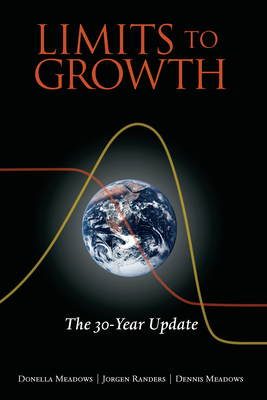The Limits to Growth: The 30-Year Update
Donella H. Meadows

A very good, if sobering, book.
The original of this book was written in 1972; this is an edition that the authors updated in 2002, 30 years after the original. The book is a discussion of physical limits associated with the expansion of the human population and economy: arable land, potable water, nonrenewable resources, etc. The authors are systems researchers and they make use of a computer model that describes positive and negative feedback loops for a wide variety of things, including demographic expansion, investment and consumption, use of renewable and nonrenewable resources, pollution, etc; they calibrate these to the best available actual data. The model covers a lot of ground, but given that, it seems relatively straightforward.
The authors are definitely “modelers after my own heart.” They talk a lot about the strengths and shortcomings of the model, and often describe sensitivity tests they have run when there is a significant amount of uncertainty around a given model parameter. They value parsimony in the model. They exclusively rely on the model to generate conditional and qualitative forecasts, rather than claiming to make precise quantitative forecasts. Best of all, they made the model code publicly available so that anyone could replicate their results or run alternative assumptions.
The argument of the book is quite sobering, though. In nearly all of their simulation runs, the world hits some kind of “wall” at some point in the twenty-first century, followed by a fairly catastrophic decline in average living standards. These take many different forms, including food shortages, natural resource shortages, severe environmental damage, etc. One thing that the authors emphasize is the interconnected nature of these limits–that if one crisis is averted in the model, it tends just to lead to another. This is because any crisis aversion efforts are drawing on a finite pool of capital–the population in the model can’t maintain living standards, reduce use of nonrenewable resources, increase the food supply, etc., all at the same time. One useful metaphor that the authors often employ is of a car with unreliable brakes. Problems that are manageable at a low speed become unmanageable at a higher speed; the appropriate response is to slow down, but this is a response that is completely alien to humanity’s conception of the economy and development.
The general conclusion that crisis is likely (though not inevitable) rests on a fairly simple set of premises, which remind me in style of the simple premises on which Darwin bases his natural selection argument:
-Growth (exponential growth) in the physical economy is considered desirable.
-There are physical limits to the sources of materials and energy, and to the sinks for waste.
-Signals about the physical limits are noisy and delayed, and responses to these signals are also delayed.
-The limits are erodable when overused; you can exceed the sustainable level of use of some resource temporarily, but the result is often that the sustainable level is decreased going forward. (Think of an overfished fishery.)
These seem more or less convincing to me. The authors do manage to find scenarios in the model in which crisis is averted, but they require two things in concert: improvements in technology, AND a commitment to limit average living standards and population growth. Neither of these things in isolation is enough. And, although the model shows these commitments working if enacted in 2002, they are “too late” if enacted in 2022. Of course, the authors would not hold to this as an exact numeric prediction, but rather as a qualitative finding that there is some limited window of time in which even drastic action can be effective. Being more than half way to 2022, I can’t imagine any such commitment happening.
I like the overall style of the book. Along with the discussion of modeling, they intersperse case study discussions, such as the global effort to stop emissions of CFCs to stop damaging the ozone layer, or the lack of efforts to stop fishery collapse. In addition, the authors are not afraid to discuss what Minsky would call their “pre-analytic visions,” nor are they afraid to include a section called “Loving” near the end in their discussions of tools to bring us to a more sustainable path.
Great book. Very depressing.